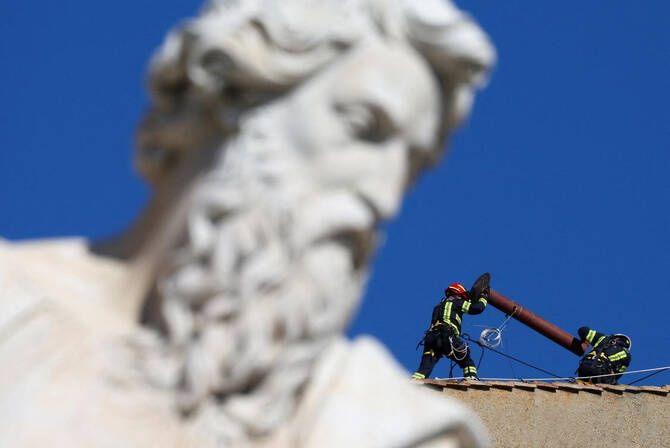Vatican chimney installed ahead of papal conclave

Firefighters installed the chimney atop the Sistine Chapel on Friday which will emit white smoke to signal the election of a new pope as preparations proceed just five days before cardinals gather for the conclave, Azernews reports, citing Arab News.
Some 133 Catholic cardinals will gather below Michelangelo’s famed frescoes in the 15th-century chapel, situated inside the Apostolic Palace at the Vatican, to elect a successor to Pope Francis.
Held behind locked doors, the conclave will signal to the world
the outcome by burning ballots in a special stove, with the chimney
emitting black smoke if no one has been elected, or white smoke if
there is a new pope.
Cardinals from around the world have been called back to Rome
following the death on April 21 of Francis, an energetic reformer
from Argentina who led the Catholic Church for 12 years.
All but four of the cardinal electors — those aged under 80 — who can vote in the conclave are already in Rome, Vatican spokesman Matteo Bruni said.
Ahead of the election, cardinals of all ages have been meeting daily at the Vatican to discuss the challenges facing the next head of the world’s 1.4 billion Catholics.
Friday’s meeting emphasized spreading the Catholic faith, the need for unity and the risk of “counter-witness” — problems such as sexual abuse and financial scandals — among other issues, Bruni told reporters.
Cardinal Luis Antonio Tagle of the Philippines, Italy’s Pietro Parolin — who served as secretary of state under Francis — and Ghana’s Peter Turkson are among the favorites to be the next pope.
But there is an old Roman saying that he who enters the conclave a pope, leaves a cardinal — a warning that the favorite rarely emerges as the winner.
“I think the Church is in prayer mode, but it must also put itself in surprise mode,” Cardinal Gregorio Rosa Chavez, 82, told reporters as he headed into Friday morning’s meeting.
“Remember what happened with Pope Francis — what a surprise!“
Among the crowds of tourists and pilgrims in St. Peter’s Square on Friday, the installation of the chimney on the Sistine Chapel — a thin metal tube with a capped top — went largely unnoticed.
But many were aware that history was in the making.
“It definitely is a historic moment and it definitely feels special to be in Rome,” said Glenn Atherton, a Briton visiting from London.
“It feels like a once-in-a-lifetime thing,” he told AFP.
There are 135 cardinals eligible to vote in the conclave, but two have withdrawn for health reasons.
These were Cardinal Antonio Canizares Llovera, Archbishop emeritus of Valencia in Spain, and Cardinal John Njue, Archbishop emeritus of Nairobi in Kenya, the Vatican confirmed.
The conclave is due to begin at 4:30 p.m. (1430 GMT) on Wednesday, where the cardinals will take an oath to maintain the secrecy of the election, on pain of excommunication.
That first day they will hold one ballot, with the winner — technically any baptised male, but in reality always one of their own — needing a two-thirds majority, or 89 votes, to win.
During the following days they will hold two votes in the
morning and two in the afternoon.
If a winner is elected, the ballots will be burned in the special
stove with the addition of chemicals to emit a white smoke to alert
the waiting world to the decision.
If no candidate has enough votes during the first morning vote, the cardinals will proceed to a second vote, and only after that point will the ballots be burned.
The afternoon session follows the same procedure — if a pope is elected, there will be white smoke, but if not, the cardinals will proceed to a second vote and only after that will the ballots be burned.
If no pope is elected, the smoke emitted by the chimney is black.
The ancient signalling system — which still remains the only way the public learns whether a pope has been elected — used to involve mixing wet straw with the ballots to produce white smoke, and tarry pitch to create black smoke.
But after several episodes in which greyish smoke caused confusion, the Vatican introduced a new system in 2005.
At the last conclave, in 2013, the Vatican said it used a mixture of potassium perchlorate, anthracene and sulfur to produce black smoke, and potassium chlorate, lactose and rosin for white.
Two stoves stand in a corner of the chapel, one for burning the ballots and the other for the chemicals, with the smoke from both stoves going up a common flue, it said then.
Details for the procedure of next week’s conclave have not yet been confirmed.
Here we are to serve you with news right now. It does not cost much, but worth your attention.
Choose to support open, independent, quality journalism and subscribe on a monthly basis.
By subscribing to our online newspaper, you can have full digital access to all news, analysis, and much more.
You can also follow AzerNEWS on Twitter @AzerNewsAz or Facebook @AzerNewsNewspaper
Thank you!
